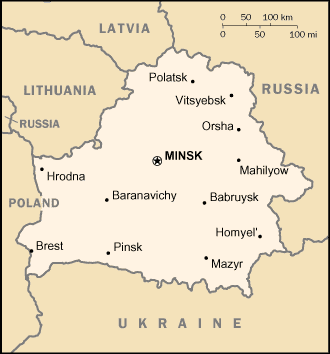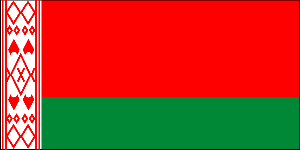
|
Belarus
Background:
After seven decades as a constituent republic of the USSR, Belarus attained
its independence in 1991. It has retained closer political and economic ties to
Russia than any of the other former Soviet republics. Belarus and Russia signed
a treaty on a two-state union on 8 December 1999 envisioning greater political
and economic integration; Belarus has agreed on the framework for
implementation of the accord.
Location:
Eastern Europe, east of Poland.
Area: Total: 207,600 sq km.
Area - comparative: Slightly smaller than Kansas.
Land boundaries: Total: 2,900 km border countries: Latvia 141 km, Lithuania
502 km, Poland 407 km, Russia 959 km, Ukraine 891 km.
Climate and Terrain:
Climate: Cold winters, cool and moist summers; transitional between continental
and maritime.
Terrain: Generally flat and contains much marshland.
Elevation extremes: Lowest point: Nyoman River 90 m highest point:
Dzyarzhynskaya Hara 346 m.
Natural resources: Forests, peat deposits, small quantities of oil and natural
gas, granite, dolomitic limestone, marl, chalk, sand, gravel, clay.
People:
Population: 10,335,382.
Ethnic groups: Belarusian 81.2%, Russian 11.4%, Polish, Ukrainian, and other
7.4% .
Religions: Eastern Orthodox 80%, other (including Roman Catholic, Protestant,
Jewish, and Muslim) 20%.
Languages: Belarusian, Russian, other.
Government:
Government type: Republic.
Capital: Minsk.
Independence: 25 August 1991 (from Soviet Union).
Economy overview:
Belarus has seen little structural reform since 1995, when President LUKASHENKO
launched the country on the path of "market socialism." In keeping with this
policy, LUKASHENKO re-imposed administrative controls over prices and currency
exchange rates and expanded the state's right to intervene in the management of
private enterprise. In addition to the burdens imposed by high inflation and
persistent trade deficits, businesses have been subject to pressure on the part
of central and local governments, e.g., arbitrary changes in regulations,
numerous rigorous inspections, retroactive application of new business
regulations, and arrests of "disruptive" businessmen and factory owners. Close
relations with Russia, possibly leading to reunion, color the pattern of
economic developments.
GDP - composition by sector: Agriculture: 13% industry: 42% services: 45%.
Statistics:
Telephones - main lines in use: 2.313 million.
Telephones - mobile cellular: 8,167.
Radio broadcast stations: AM 28, FM 37.
Radios: 3.02 million.
Television broadcast stations: 47.
Televisions: 2.52 million.
Internet users: 180,000.
Railways: Total: 5,523 km broad gauge: 5,523 km 1.520-m gauge (875 km
electrified).
Highways: Total: 98,200 km paved: 66,100 km, unpaved: 32,100 km.
Airports: 136.
Airports - with paved runways: 33, with unpaved runways: 103.
Return to Visiting Locations
|

